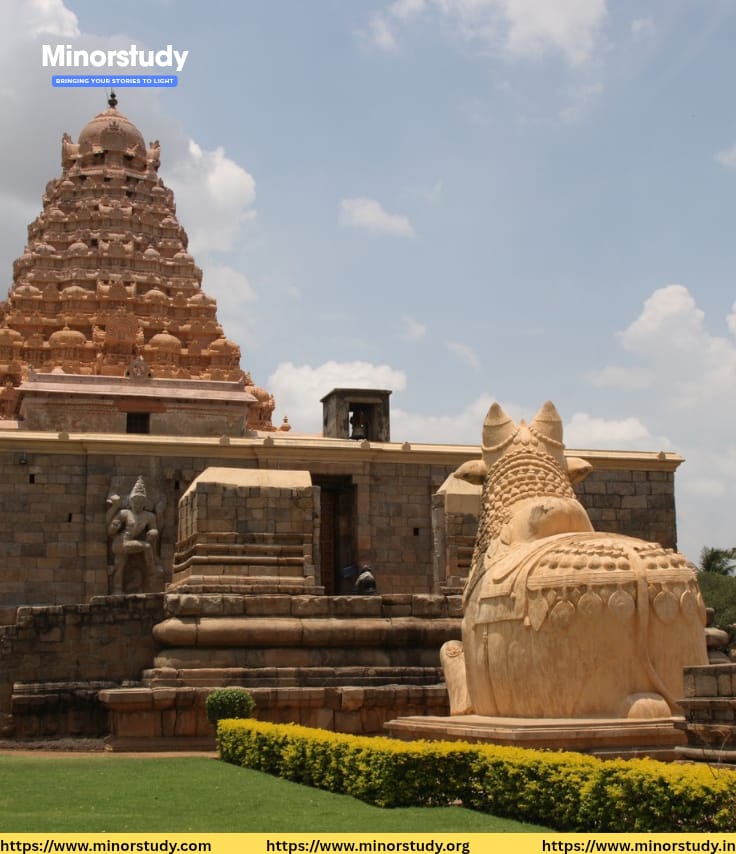🛕 Peruvudaiyar Kovil: 9 Stunning Reasons Why It’s an Underrated Marvel of Indian Heritage
Peruvudaiyar Kovil: India is adorned with countless temples that speak volumes of its rich spiritual and architectural history. Among them, Peruvudaiyar Kovil — also popularly known as Brihadeeswarar Temple — is a shining jewel in the Tamil heritage crown. Located in Thanjavur, Tamil Nadu, this UNESCO World Heritage Site is not just a place of worship, but a breathtaking narrative of art, devotion, and engineering brilliance.
- 🏛️ What is Peruvudaiyar Kovil?
- 📜 History of Peruvudaiyar Kovil
- 📅 Timeline: Key Milestones
- 🌟 9 Fascinating Facts About Peruvudaiyar Kovil
- 🙋♂️ FAQs about Peruvudaiyar Kovil
- 🎯 Cultural and Historical Significance
- 🧘 Importance in Daily Life
- 1. Spiritual Stability
- 2. Architectural Inspiration
- 3. Cultural Identity
- 4. Education and Research
- 5. Tourism and Economy
- 🙏 Wishing and Observance
- 📌 Important Points to Remember
- 🧠 Why It’s Important to Society
- ❤️ Conclusion: Its Impact on Daily Life
- 🌺 Final Message: A Wish from the Ages
In this human-friendly, in-depth article, let’s discover everything about Peruvudaiyar Kovil — its history, facts, significance, timeline, daily life impact, observance, FAQs, and why this temple remains a symbol of eternal grandeur.
🏛️ What is Peruvudaiyar Kovil?
Peruvudaiyar Kovil, dedicated to Lord Shiva, is a Dravidian-style temple built by the mighty Chola emperor Raja Raja Chola I. Completed in the early 11th century CE (around 1010 CE), it is one of the largest and tallest temples in India.
Popularly referred to as Brihadeeswarar Temple, it is revered for:
Its massive scale
Monolithic dome weighing 80+ tons
Intricate carvings and murals
Enduring spiritual significance
📜 History of Peruvudaiyar Kovil
The Vision of a Divine Monarch
The temple was constructed during the reign of Raja Raja Chola I (985–1014 CE).
Completed in just 7 years, this architectural marvel was named “Peruvudaiyar Kovil” to signify the “Great Lord” — a reference to Lord Shiva.
It was a symbol of imperial power, divine connection, and cultural pride.
The inscriptions in the temple speak volumes about the social structure, donations, artists, and administrative practices of the Chola period.
📅 Timeline: Key Milestones
| Year | Event |
|---|---|
| 985 CE | Ascension of Raja Raja Chola I |
| 1003 CE | Construction of the temple begins |
| 1010 CE | Temple completed and consecrated |
| 14th–16th c | Temple underwent modifications under Nayaks and Marathas |
| 1987 | Recognized as a UNESCO World Heritage Site |
| 2010 | 1000th year celebration of the temple by Tamil Nadu Government |
🌟 9 Fascinating Facts About Peruvudaiyar Kovil
World’s First Complete Granite Temple – The entire temple is made using granite, a stone not found locally.
Massive Shikhara (Vimana) – The temple tower stands at 66 meters, making it one of the tallest in India.
Monolithic Dome – The 80-ton capstone was placed without cranes — still a mystery to engineers today.
World Heritage Recognition – Part of the “Great Living Chola Temples” declared by UNESCO.
Shadowless Vimana – It is believed the main tower doesn’t cast a shadow at noon, a testament to architectural genius.
Extensive Murals and Frescoes – Preserved Chola-era paintings still adorn the temple’s corridors.
Bronze Sculptures Originated Here – The Cholas were pioneers in bronze casting, and many of these began at this site.
Sacred Lingam – The Shiva Lingam is over 13 feet tall, among the largest in India.
Still Active Worship Site – Even after a millennium, daily rituals, festivals, and pujas are conducted.
🙋♂️ FAQs about Peruvudaiyar Kovil
Q1: Where is Peruvudaiyar Kovil located?
📍 It is situated in Thanjavur, Tamil Nadu.
Q2: Who built Peruvudaiyar Kovil?
🛕 It was built by Raja Raja Chola I during the Chola dynasty.
Q3: Is Peruvudaiyar Kovil still active as a temple?
Yes! Daily rituals and festivals continue as per the Saivite tradition.
Q4: Why is it also called Brihadeeswarar Temple?
“Brihad” means “great” — thus, Brihadeeswarar means the Great Lord Shiva.
Q5: What’s unique about its architecture?
The temple has a self-balanced dome, massive granite sculptures, and intricate inscriptions without any modern machinery used in its construction.
🎯 Cultural and Historical Significance
🛕 A Pinnacle of Chola Art
Peruvudaiyar Kovil is the finest representation of Dravidian temple architecture. It mirrors the zenith of Chola art and thought, especially in:
Sculpture
Metal casting
Literature (through inscriptions)
Temple planning
🧠 An Open Book of History
The inscriptions inside the temple walls provide details about:
Chola administration
Taxation and economy
Roles of women and temple workers
Devadasi system and community contribution
🪔 A Spiritual Beacon
For over a thousand years, it has been a sacred site for Shiva devotees and a spiritual center for Shaivism.
🧘 Importance in Daily Life
Although built centuries ago, Peruvudaiyar Kovil continues to influence modern society and spiritual practice in many ways:
1. Spiritual Stability
It reminds people of divine permanence in a rapidly changing world. A visit or virtual darshan of this temple offers deep inner peace.
2. Architectural Inspiration
Civil engineers and architects study the temple’s construction to understand ancient building techniques and planning.
3. Cultural Identity
For Tamil people and Indians, this temple is a living symbol of ancient wisdom, artistic refinement, and faith.
4. Education and Research
From schools to universities, the temple is used as a case study in art, archaeology, religion, and history curricula.
5. Tourism and Economy
The temple draws tourists worldwide, boosting local artisans, guides, restaurants, and hotels.
🙏 Wishing and Observance
When visiting or thinking about Peruvudaiyar Kovil, many people wish:
“May the grace of Lord Brihadeeswara fill our homes with wisdom, strength, and peace.”
Ways to Observe:
Attend Mahashivratri celebrations at the temple
Support local heritage preservation groups
Share stories and knowledge about the temple through social media or community discussions
Conduct educational sessions on Indian temple architecture
📌 Important Points to Remember
✅ Built in 1010 CE by Raja Raja Chola I
✅ Dedicated to Lord Shiva (Brihadeeswara)
✅ A UNESCO World Heritage Site
✅ Made entirely of granite, even the 80-ton dome
✅ Daily rituals and festivals still conducted
✅ Inscriptions are primary sources of historical data
✅ Architecturally aligned with cosmic and solar principles
🧠 Why It’s Important to Society
In an age of rapid technological advancement, Peruvudaiyar Kovil reminds us that:
Spirituality and science can coexist
Community-driven construction leads to timeless architecture
Art and devotion build not just monuments but also societies
Preservation of heritage teaches respect for the past and responsibility for the future
It’s more than a tourist destination — it’s a living temple, a university of stone, and a museum of human potential.
❤️ Conclusion: Its Impact on Daily Life
Whether you’re a traveler, student, devotee, or someone seeking cultural roots, Peruvudaiyar Kovil leaves a deep mark.
It inspires discipline through devotion
It teaches legacy through architecture
It grounds us in cultural consciousness
It uplifts us with spiritual purpose
In daily life, reflecting on such historical marvels promotes humility, reverence, and a deeper connection to our heritage.
🌺 Final Message: A Wish from the Ages
“Let the granite wisdom of Peruvudaiyar Kovil remind us that faith, artistry, and unity can withstand time itself.”








